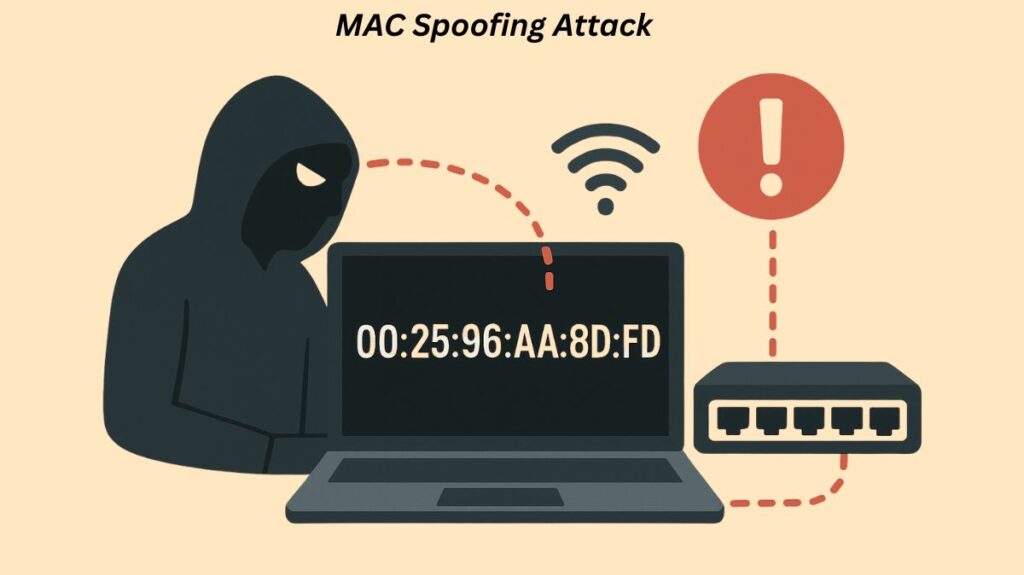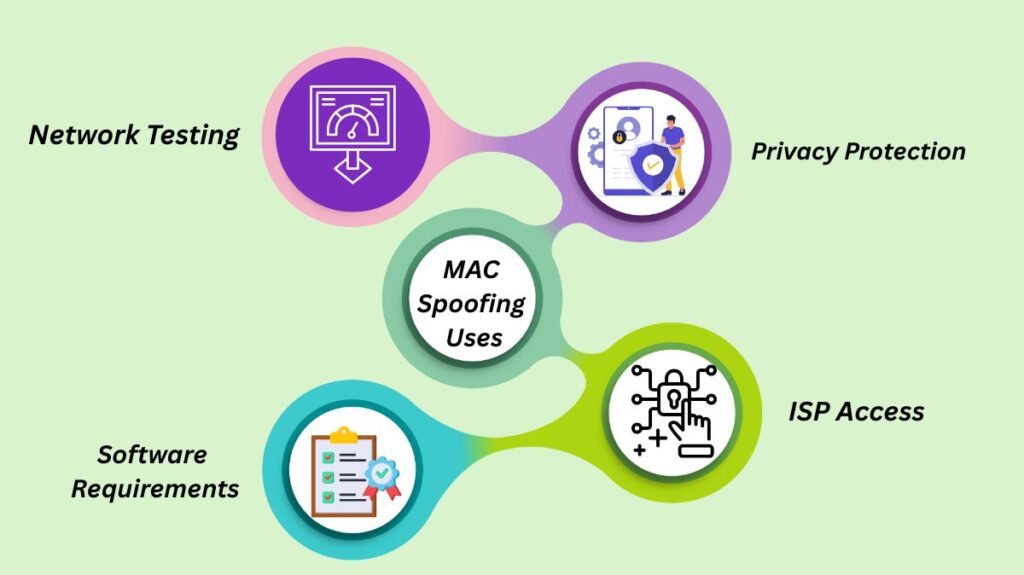What is MAC Spoofing Attack?

A method for changing the factory-assigned Media Access Control (MAC) address of a device’s network interface is called MAC spoofing. Faking your MAC address is basically what it is.
Both legal and illegal uses are possible for MAC spoofing. Malicious use of this kind of attack is intended to take advantage of weaknesses in networking hardware’s authentication systems.
Understanding the MAC Address
To fully grasp MAC spoofing, it is helpful to understand the Media Access Control (MAC) address:
- Definition: A MAC address is a special, hardware-assigned identification that is linked to a device’s Network Interface Card (NIC). It is also sometimes called a physical address.
- Layer 2 Operation: According to the OSI model, MAC addresses function at the Data Link Layer, or Layer 2.
- Format: Usually displayed in hexadecimal format, this 12-digit alphanumeric identifier consists of 48 bits (e.g., F0:0F:F0:0F:00:FF). The manufacturer’s OUI (Organization Unique Identifier) takes up the first 24 bits, while vendor-specific or NIC data takes up the following 24 bits.
- Function: Its purpose is to guide traffic within a Local Area Network (LAN) and identify devices.
Many drivers enable the MAC address to be overridden or altered at the operating system or driver level using a variety of software tools, even if it is hard-coded into the NIC.
You can also read What is SSL stripping Attack, How it Works and Prevention
How MAC Spoofing Attacks Work
An attacker can pose as another device on the network by changing their device’s MAC address in a MAC spoofing attack.
- Impersonation: The attacker modifies the MAC address of their device to match that of a trustworthy, authentic device on the network.
- Traffic Redirection: Since MAC addresses are necessary for communication inside a single LAN, altering a device’s MAC address to that of an existing network device will expose all traffic associated with the genuine device to the attacker.
- Network Perception: The spoof MAC address is detected by the network, and the switch in particular links it to the attacker’s switch port.
- Bypassing Security: This allows the attacker to get beyond network security measures like MAC-based access controls and MAC filtering, which is a security technique that limits access based on MAC addresses.
- Malicious Activity: After successfully infiltrating, the offender may carry out malevolent actions, like compromising further endpoints or stealing confidential data.
Because the attacker’s equipment is seen as a trustworthy device on the network, MAC spoofing assaults are frequently difficult to detect.
Techniques Used in MAC Spoofing
Hackers employ several techniques to execute MAC spoofing attacks:
Cloning:
Cloning is the process of copying a genuine device’s MAC address to impersonate that device on the network. This technique is frequently used when a criminal has unrestricted physical access to a target device, like a router or switch.
By copying the MAC address of the authorized device, the criminal can get beyond MAC filtering and enter the network. When the gateway or router is the intended victim, this specific approach allows the attacker to intercept network traffic and maybe conduct subsequent attacks.
Randomizing a MAC Address:
Creating a new MAC address and utilizing it to mimic a network device is known as randomization. This technique is commonly used when an attacker does not have access to a trusted device to replicate its MAC address.
A new MAC address that has nothing to do with any known network devices is created by the attacker. The adversary has successfully gotten around the MAC filtering mechanism and obtained unauthorized access to the network by taking advantage of this vulnerability.
Network managers may find it difficult to detect MAC spoofing attacks when randomized MAC addresses are used, especially when the attacker’s equipment has no known MAC addresses.
Manual Configuration:
By using network settings or command line tools like Linux’s ifconfig or ip commands, attackers can manually alter their computer’s MAC address.
Software Tools:
Ettercap is a powerful software program used for network traffic analysis and security evaluations. Cybercriminals can also execute MAC spoofing attacks by altering MAC addresses and intercepting network traffic. Ettercap is a multifunctional, cross-platform, open-source program that works with Windows, macOS, and Linux, among other operating systems.
SMAC, Netcut, and Cain and Abel are some well-liked tools for MAC spoofing attacks. These tools can be used for MAC address cloning or randomization, as well as MITM attacks.
You can also read HTTPS Spoofing Explained: Techniques, Risks And Prevention
Objectives and Related Attacks
MAC spoofing is frequently utilized to enable broader cyberattacks:
- Impersonation: To get around Access Control Lists (ACLs) or obtain network access, impersonation involves posing as a crucial device, such as a gateway, server, printer, or particular user device.
- Man-in-the-Middle (MITM) Attacks: Attacks known as “Man-in-the-Middle” (MITM) occur when an attacker listens in on communications between two devices via MAC spoofing. This frequently entails posing as an Access Point (AP) or other piece of infrastructure in a public setting.
- ARP Spoofing: By faking their MAC address and the IP address of a genuine device, hackers can transmit phoney Address Resolution Protocol (ARP) messages.
- Rogue/Evil Twin Attacks: To obtain and log a client’s traffic, the hostile actor poses as that client or AP.
- Evading Forensics and Bans: Following an incident, attackers may spoof their MAC address to get access to a network from which they were banned or modify it to escape tracking.
- Credential Theft: In one notable instance, a malevolent actor used MAC spoofing to change the MAC address of their device to match that of a bank employee’s device. This gave them access to the SWIFT payment system and enabled them to steal $81 million from Bangladesh Bank in 2016.
Legitimate Uses of MAC Spoofing

While often associated with malicious activity, MAC spoofing is also employed for authorized or privacy-focused reasons:
- Privacy Protection: Since MAC addresses are not secured and can be used for tracking, users may spoof them to conceal their identities and safeguard their privacy, particularly on Wi-Fi networks. MAC address randomization is a feature of contemporary operating systems like iOS, Android, Linux, and Windows 10 that stops tracking when a user connects to a wireless network.
- ISP Access: To keep service without getting in touch with the Internet Service Provider (ISP), a user may spoof the MAC address of a single device on fresh hardware if the ISP registers and limits service to that address.
- Software Requirements: To install software on systems with pre-defined MAC addresses in accordance with software license agreements.
- Network Testing: To identify network problems or test how the network responds to a particular device, network engineers may fake MAC addresses.
Detection and Prevention
Network administrators can look for several warning signs of MAC spoofing attacks:
- Duplicate IP addresses: Multiple network devices sharing the same IP address are known as duplicate IP addresses.
- Unknown MAC addresses: The existence of unknown MAC addresses on the network is known as unknown MAC address presence.
- MAC moves/flapping: The same MAC address is quickly learnt and deleted across ports, or it is seen on several switch ports in a brief amount of time.
- Unusual network activity or unexpected network failures.
To prevent MAC spoofing, networks should not rely on MAC addresses alone for security. Effective mitigation includes:
- Access Control Hardening: Using port security on wired networks to restrict the number of permitted MAC addresses per port (and sometimes shutting the port down if the limit is exceeded) is known as access control hardening.
- Authentication Protocols: Implementing 802.1X (dot1x) authentication, which prevents access by merely faking a MAC address, requires devices to authenticate with credentials (such as certificates) before receiving network access.
- Dynamic ARP Inspection (DAI): To stop hackers from creating MAC-to-IP bindings, this security feature verifies ARP requests and answers.
- Zero Trust: Putting in place a security framework that demands that all devices and users be validated and approved before they can access resources, even if they can successfully spoof a MAC address.
- Network Segmentation: Using ACLs or Private VLANs to divide the network into smaller subnets to reduce exposure in the event of spoofing.
You can also read Rogue DHCP Server Detection And Mitigation Techniques
